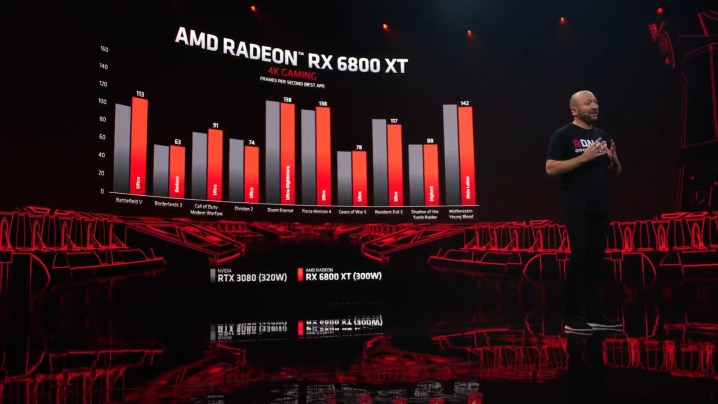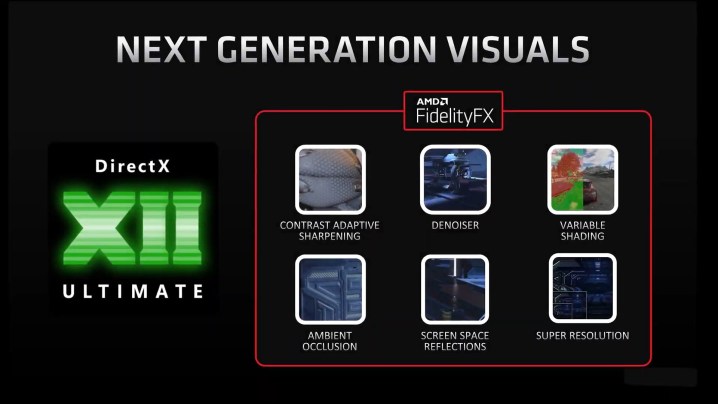With the PS5 and Xbox Series X now out in the wild, it’s no surprise that AMD fans have been champing at the bit to try out the PC version of its new RDNA 2 graphics cards. RX 6000-series GPUs are now available too, and they really bring the fight to Nvidia’s best. The new RX 6800 XT is positioned to challenge Nvidia’s recent RTX 3080, and at $70 less, it’ll save you a little money, too.
More importantly, though, AMD’s next-gen GPUs are arriving at an opportune time, as stock shortages persist for Nvidia’s latest cards. That’s something team red could take serious advantage of. If it can keep its own cards in stock, that is.
In this guide, we’re going to cover the RX 6800 XT versus the RTX 3080 so you know which card to pick up for your next build.
Pricing and availability

AMD’s new RX 6800 and 6800 XT launched on November 18 for $579 and $649, respectively. At only $70 less than the RTX 3080, the 6800 XT probably won’t win over many users purely based on price, though it’s at least staying competitive, especially compared to 3080 board partner cards.
At the end of October 2020, however, the RTX 3080 isn’t in stock anywhere. Nvidia has struggled to get a handle on its 30-series launch, following reports of poor yields of the Samsung 8nm node powering Nvidia’s new cards. The RTX 3080 is sold out everywhere right now, and it’ll likely stay that way well into 2021. AMD’s RX 6800 XT has only just gone on sale and as we would expect it has immediately sold out, however we have heard reports that AMD has increased production of its Big Navi graphics chips at TSMC. We feel optimistic AMD will overcome its supply problems in a reasonable timeframe and predict you are more likely to find stocks of AMD RX 6800 XT than Nvidia RTX 3080 by early 2021.
Historically, TSMC — the foundry behind the 7nm node in the RX 6800 XT — has been able to meet demand with high-volume manufacturing. Especially moving into the holiday season, AMD could steal back some significant market share from Nvidia if it can keep cards on shelves. The RX 6800 XT is already cheaper than RTX 3080 but the big news is that AMD’s performance claims have been verified and the RX 6800 XT matches the performance of the RTX 3080 in most games.
Specs and performance

It’s hard to directly compare AMD and Nvidia GPUs purely based on specs, and that’s not changing with AMD’s new RX 6000 cards. That said, there are some aspects that are more comparable. We can see some stark differences between the 6800 XT and RTX 3080 in terms of memory. The 6800 XT has 16GB to the 3080’s 10GB, though Nvidia’s card uses newer, faster GDDR6X memory and has a wider memory bus, which gives the RTX 3080 a greater standard memory bandwidth.
AMD has a trick up its sleeve, though. Its new Infinity Cache accelerates memory bandwidth by a huge margin, delivering a potential memory bandwidth over twice that of the RTX 3080 in some scenarios.
| RX 6800 XT | RTX 3080 | |
| GPU | Navi 21 | GA102 |
| Interface | PCI Express 4.0 | PCI Express 4.0 |
| GPU Cores | 4,608 Stream processors | 8,704 CUDA cores |
| Ray tracing cores | 72 Ray Accelerators | 68 Gen 2 RT cores |
| Tensor cores | N/A | 272 |
| Base clock | TBD | 1,440MHz |
| Game clock | 2,015MHz | N/A |
| Boost clock | 2,250MHz | 1,710MHz |
| Memory | 16GB GDDR6 + 128MB Infinity Cache | 10GB GDDR6X |
| Memory speed | 16Gbps | 19Gbps |
| Memory bus | 256-bit | 320-bit |
| Bandwidth | 512GBps (1,664GBps effective) | 760GBps |
| TDP | 300W | 320W |
AMD promised us their RX 6800 XT would match the RTX 3080 at 4K in a number of games and now the reviews are in we can see that AMD’s latest card is within a few frames per second of the RTX 3080. If you look at benchmarks in a game such as The Division 2 you will see at 1080p Nvidia has an advantage of 5 fps that stretches to 10 fps at 1440p and 4K. In Borderlands 3 the tables are turned with AMD beating Nvidia by the same margins.
It is fair to say that Nvidia has retained the performance crown but very few of us will be able to detect those differences in frame rates by eye, so the fairest summary is that AMD RX 6800 XT and Nvidia RTX 3080 are competing on level terms.

Based on our testing of the RTX 3080, we know AMD’s competing numbers are at least close. In Battlefield V, the card reached 97 fps at 4K with Ultra settings and 147 fps at 1440p. The 1440p numbers are a little high in AMD’s charts, though 4K performance is around what we’d expect. Now we know the RX 6800 XT can match the performance of the RTX 3080, we expect to see AMD reclaiming market share from Nvidia, especially if AMD has better stock availability.
AMD is introducing two new features with the launch of RX 6000 GPUs that could further boost performance. Rage Mode is a new one-click overclocking tool built into the Radeon software, allowing you to get the most out of your graphics card with minimal tweaking. The exciting new addition, however, is Smart Access Memory. AMD’s upcoming Ryzen 5000 processors can take full control of RX 6000-series GPUs. According to AMD’s benchmarks, using both can offer up to a 13% performance improvement at 4K.

This is highly dependent on the game, it seems. Although AMD showed off a 13% improvement in Forza Horizon 4, Doom Eternal only saw a 2% improvement.
Ray tracing and other features

AMD was quick to highlight hardware support for DirectX 12 during its RX 6000 reveal event, and follow-up reports have given us some idea about its potential performance. AMD includes a single Ray Accelerator on each compute unit, meaning the RX 6800 XT has 72 of them in total. Some third-party testing and AMD’s own numbers give us a rough comparison of RX 6800 XT and RTX 3080 Ray Tracing performance, and the RTX 3080 wins handily. The confirmation comes in synthetic tests such as 3DMark – Port Royal where the RX 6800 XT is beaten by Nvidia’s RTX 3080 and also by the RTX 2080 Ti.
We are still in the early days of benchmarks that test Ray Tracing, so the impact of this technology is hard to assess, but it became apparent with Nvidia’s RTX 20-series GPUs that Ray Tracing takes a huge toll on performance. This means that Nvidia’s DLSS is an important feature as it allows Nvidia to boost image quality with Ray Tracing and then offset the hit first with DLSS and now with DLSS 2.0. It can make a massive difference too, with intense ray tracing games like Minecraft being entirely playable at 4K with all the lighting effects turned up, when DLSS is enabled, but barely creeping above 30 fps on AMD hardware.
AMD guarantees many performance-optimizing perks on its products, such as adaptive sharpening and varying-rate shading, but we have yet to find another similar option to DLSS. AMD announced that they have a new Super Resolution feature in the making, but we still don’t know when it’s due to debut. Without testing it ourselves, we can’t say if it will be an adequate alternative to DLSS.
The $70 difference
Based on everything we’ve been able to test, we’ve found that AMD and Nvidia offer pretty similar features and performance. The RTX 3080 appears to be slightly quicker and has a card with more features; however, it’s harder to find, is expensive, and lacks functionality when it comes to memory. If differences are negligible, we’d recommend saving the extra $70 by opting for the RTX 3080.
The RTX card is an excellent option if you typically play games that utilize DLSS and ray tracing. However, if you need to play standard rendered 4K resolution games, either card is a fantastic candidate. You can’t go wrong with either one of these cards as they are practically interchangeable, so you can either go for the card that’s cheaper at your local retailer or the one that they have on hand.



